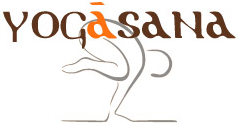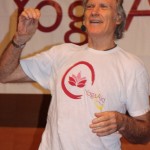 Lucas Rockwood (LR) interviews Michel Besnard (MB) and asks him to share with us his views on what it takes to become a Yoga teacher and his advice to students who are considering become a yoga teacher, but are unsure of whether if it is the right decision.
Lucas Rockwood (LR) interviews Michel Besnard (MB) and asks him to share with us his views on what it takes to become a Yoga teacher and his advice to students who are considering become a yoga teacher, but are unsure of whether if it is the right decision.
LR: Michel, you’ve been practicing and teaching yoga longer than anyone I know personally. Can you tell me what you think is the single most-important goal that any yoga teacher should have when he/she comes into class?
MB: This is a difficult question, Lucas, and four things come to mind: attitude, confidence, compassion, and awareness.
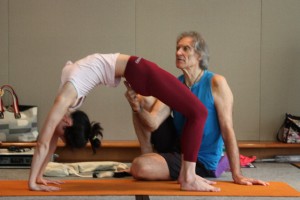 Attitude: a teacher must have the right attitude
Attitude: a teacher must have the right attitude- Confidence: a teacher must inspire confidence in his or her students and that confidence comes from knowing—and a teacher develops confidence through personal practice and self study
- Compassion: it’s important that a teacher can connect to the students and be understanding
- Awareness: to develop an acute sense of “observation,” awareness of yourself, and awareness of the students. When you walk into a class, you need to be in tune with where your students are coming from by watching their body language so you can guide students mindfully
LR: What advice would you give to students who are considering become a yoga teacher, but are unsure of whether it’s the right decision?
MB: My philosophy is “there is no right or wrong decision.” When you make a decision, it may not be the result we expected. However, it was the right decision though it may not have been the result you expected. “The total acceptance of what it is”.
Whatever we do in life how do we know is the right decision? Nobody can answer that question. The only way to find out by going through that experience by “JUST DOING IT” therefore one will know going through that experience whether or not becoming a Yoga Teacher is for him/her.
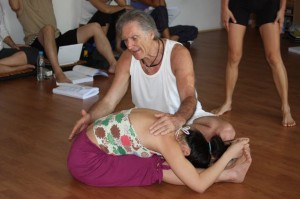 If you have been practicing yoga for say two years or so and you have been thinking to become a Yoga Teacher all I would say “Keep an open mind IMMERSE YOURSELF TOTALLY and go through the experience, then you can make a rational decision otherwise you cannot. How many people want to do something and decide it’s not for them and a few years later have regrets because they did not do it at that time. Most people live in regrets “IF I HAVE DONE THAT I WILL BE…” and therefore never achieve anything.
If you have been practicing yoga for say two years or so and you have been thinking to become a Yoga Teacher all I would say “Keep an open mind IMMERSE YOURSELF TOTALLY and go through the experience, then you can make a rational decision otherwise you cannot. How many people want to do something and decide it’s not for them and a few years later have regrets because they did not do it at that time. Most people live in regrets “IF I HAVE DONE THAT I WILL BE…” and therefore never achieve anything.
Doing a Teacher’s Training say for one month it is a kind of personal growth, your yoga knowledge will increase, your practice will improve, you will know yourself better, your personality will improve and you will have a totally different outlook about your own life.
From my experience, I have found over the year when a person is unsure whether becoming a yoga teacher or not; two things happen after completing the Teacher’s Training: He or she does not want to become a teacher but want to further their Yoga knowledge and want to do more training; He or she decide to become a Yoga teacher eager to share the knowledge he or she acquired with other people.
LR: We all know that there is much more to yoga than just the physical practice, but we also know how powerful the practice of asana and pranayama can be — and how accessible it is compared to meditation or other spiritual practices. What are your views on the role of asana and pranayama in the bigger picture? Do yoga poses matter?
MB: Asanas plays an extremely important role because I believe asanas really prepare us for Pranayama and meditation
What is Yoga? “Yogas-citta-vritti-nirodhah”, “Yoga is the restriction of the fluctuation of consciousness” chapter 1 sutra 2 of the Yoga sutras of Patanjali. And this is achieved through Pranayama and Meditation.
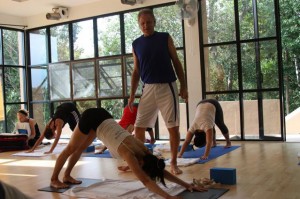 From my own experience, asanas are the foundation yes they do matter. I like to quote B.K.S Iyengar “My body is the temple of my soul and Asanas are my pray”. Asanas are a very good foundation for Pranayama and Meditation; why? Because the more the body is open the more one can sit for a fair amount of time without too much discomfort. When the body is stiff it is very difficult to sit quietly because the mind is busy with the discomfort of various part of the body.
From my own experience, asanas are the foundation yes they do matter. I like to quote B.K.S Iyengar “My body is the temple of my soul and Asanas are my pray”. Asanas are a very good foundation for Pranayama and Meditation; why? Because the more the body is open the more one can sit for a fair amount of time without too much discomfort. When the body is stiff it is very difficult to sit quietly because the mind is busy with the discomfort of various part of the body.
I remember when I started Hatha Yoga a year later I went to do a 12 days Meditation retreat where I had to sit for 8 hours everyday and it was not pleasant experience because I was more concerned about my bodily pain than concentrating on my breath. So one needs to prepare himself or herself to sit for a while without feeling any discomfort otherwise you cannot concentrate. Asanas prepare you for Pranayama and Meditation.
Asanas are important but one must not be obsessive with it. Asanas will not get you to Samadhi. BUT IT WILL PREPARE YOU. Therefore, after a while one needs to practice Asanas, Pranayama and Meditation.
So really yes they do matter doing the asanas preparing the body to sit and Pranayama to Meditate otherwise it is putting the cart in the front of the horse.
LR: You’ve studied with two of the most-influential modern yoga teachers of our time: B.K.S. Iyengar and Sri K. Pattabhi Jois. Can you tell me about your experiences (both good and bad) with these two men?
MB: When I first started with Iyengar, people practicing any other form of Yoga would say that Iyengar was not real yoga: it was too physical so on and so forth… however, 15 years later when I switched to Ashtanga Vinyasa Yoga, people were said the same thing: that Ashtanga Vinyasa Yoga was not real yoga! Now, for me, both have their strengths and weaknesses in their approaches.
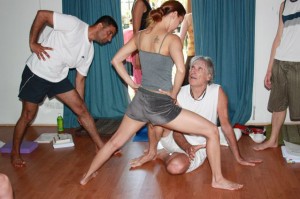 B.K.S. Iyengar was very intense then, very demanding, giving instruction with a fiery force and expecting a lot from his students—and sometimes I could feel anger and impatience coming out of him. You never ever got encouragement, and it was never good enough; however, outside of the yoga practice, I found him to be a kind, gentle, jovial person.
B.K.S. Iyengar was very intense then, very demanding, giving instruction with a fiery force and expecting a lot from his students—and sometimes I could feel anger and impatience coming out of him. You never ever got encouragement, and it was never good enough; however, outside of the yoga practice, I found him to be a kind, gentle, jovial person.
When I went for the first time to Mysore to study with Pattabhi Jois, he was very encouraging and never raised his voice. He was more like a father figure; however, I felt his adjustments were very strong and not focused on alignment—only strong adjustments. I felt that if someone had a difficult body to work with that person might get injured.
Bringing the two together (Iyengar & Ashtanga), I feel very strongly that you have the best of both worlds. If you practicing alignment (without overdoing it) with the breath and flow of Ashtanga Yoga, you then have the best combination in my mind.
LR: Yoga is growing and changing so quickly, and as someone who’s been deep in the yoga world for so long, I wonder what you think all these changes will mean for students who want to become yoga teachers in the future?
MB: When I started yoga about thirty years ago, teaching yoga was not a mainstream thing, so it was the lifestyle that attracted me, and having time for my own practice as well. I started teaching yoga after practicing for five years. So when I started teaching, I was teaching seven classes per week maximum and that was enough money to pay my everyday expenses and some surplus to go to India once a year.
Yoga has now gone mainstream, so there are more opportunities for yoga teachers; however; teachers now need to be more professional and business-minded—and competent with a computer! [Laughs]
Education in yoga has always been very important, and I feel it’s even more important now. New teachers have to realize that education in yoga philosophy, anatomy, and so on must be on-going.
You know, Lucas, there is nothing new under the sky. Yoga re-invents itself. You can say yoga is like a diamond that has many different faces. When you look at one of its faces then look again from another angle, you’ll find there are differences. It is beneficial to know yoga from the inside out. It’s good to learn how others see yoga from the face that you are not familiar with it. Be open, and you’ll enjoy and experience yoga from others’ new discoveries.
LR: Almost every teacher I’ve met tells the story of their first “a-ha” moment with yoga, the moment when they knew that yoga was going to change their life. Did you have an experience like this?
MB: Not really, well, at least I don’t remember. I was a runner, and I wanted to improve my flexibility, so I enrolled in my first ten-week intro, beginners’ yoga class. I was suffering due to my inflexible body, but I enjoyed it and could feel the benefit of doing it. During that time I found Light On Yoga by B.K.S. Iyengar, and I read the introduction several times. I got immersed in it. So I continued to go to classes once or twice a week at the studio, and I started practicing at home by myself following the Light on Yoga. Within that year, I stopped running and put all my energy in yoga.
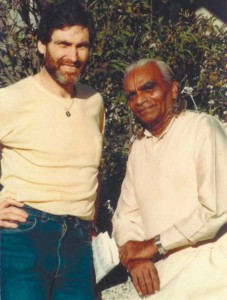 In 1983, B.K.S. Iyengar came to Australia, and I had the chance to spend some personal time with him during his stay. I was so inspired by him that I decided I would dedicate my life to yoga. I quit my job, sold my house, and bought a ticket to India. So maybe that was my first “ah-ah.” Following the Yoga path has been quite an amazing experience for me. Life is a miracle! It is amazing. When you have the least expectations, everything falls into place.
In 1983, B.K.S. Iyengar came to Australia, and I had the chance to spend some personal time with him during his stay. I was so inspired by him that I decided I would dedicate my life to yoga. I quit my job, sold my house, and bought a ticket to India. So maybe that was my first “ah-ah.” Following the Yoga path has been quite an amazing experience for me. Life is a miracle! It is amazing. When you have the least expectations, everything falls into place.
LR: If you had a room full of people and just 30 minutes to teach them the most powerful yoga practice you know, what would you teach?
MB: I would make it fun; actually when I used to run my Shala every Saturday morning I would do a very strong but fun class, which I used to call “Fun Class” and it was very popular class.
I would do a variation of sun salutations some strengthening poses, such as handstand, arm balances and a variation of back bends. I will make sure I balance the class so that the students also do a strong class and they are not left hyper. I will make sure they do a short Savasana. I believe it’s important regardless how long the class is to finish with Savasana.
LR: What advice would you give to someone who has just finished the Teacher’s Training?
MB: I would say to him or her to make sure he or she has the time to practice not to be too eager and teach 20 classes per week and not having the time to your own personal practice. One can start teaching friends or in a small Shala. I would not advise someone to start teaching in a very big studio; unless one has been practicing for a long time, though there is always exception to the rules.
I think it’s very important to start teaching so that one can get confidence and develop your own skill and style of teaching, learn to build a sequence, practice what you are going to teach that day, the experience to be in the front of a class, don’t be in a hurry.
Practice, practice, practice, see you on the mat….!
Learn more about our Yoga Teacher Training
